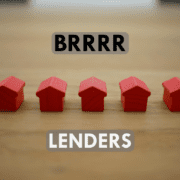How to Set Up Your BRRRR Lenders
People who win at BRRRR understand the two most important aspects of the process: getting properties undermarket, and organizing their lenders early on.
Lenders are an important member of your investment team. Here’s how to get them ready for your BRRRR investments.
BRRRR Lender Options
You’ll have a hard money or private money lender up-front. Then, in the second half of the project, you’ll have a more conventional lender with a traditional loan.
This traditional loan is usually 30-year with fixed rates, but comes with some constraints. You’re limited to ten properties with this kind of loan (including your own home). There’s also usually a limit on loan-to-value ratio, and conventional loans won’t let you put a loan in an LLC’s name.
Another option for this second loan is DSCR no-income loans. DSCR loans come in a variety of options: five- or seven-year ARMs, standard 30-year fixed mortgages, and more. Successful BRRRR investors know all their options for refinancing.
Set Your Lenders Up Ahead of Time
People who win at BRRRR set up all their lenders before they jump into a deal.
The amount loaned for the purchase and for rehab can very a lot from lender to lender. Good investors will always know how much their hard money lenders will give them.
Hard Money Mike, for example, does a lot of 100% loans if the cost is 75% less than ARV because we know the investor can easily refinance out. We know we can set them up with a rate-and-term refinance, and they’ll have no money out-of-pocket.
BRRRR winners don’t get into a property, get it fixed up, and then figure out the long-term loan. Winners figure out first whether they can get the cash out they need, and how.
Smart BRRRR investors have a pool of lenders they work with. They know what each lender can offer, and which will best fit their current strategy, ability, and deal.
Read the full article here.
Watch the video here:


